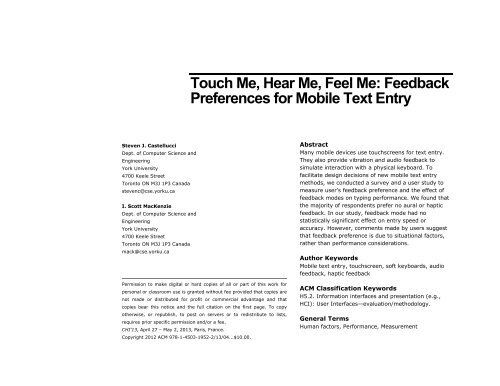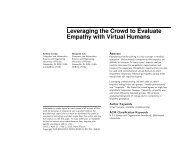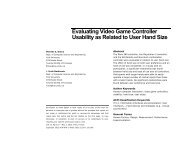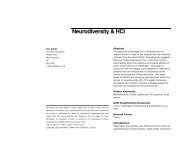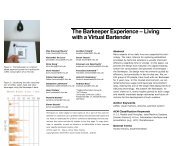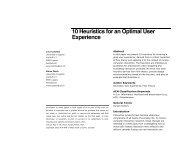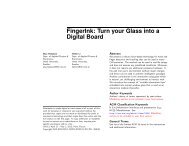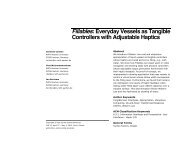Feedback Preferences for Mobile Text Entry - alt.chi 2013
Feedback Preferences for Mobile Text Entry - alt.chi 2013
Feedback Preferences for Mobile Text Entry - alt.chi 2013
You also want an ePaper? Increase the reach of your titles
YUMPU automatically turns print PDFs into web optimized ePapers that Google loves.
Steven J. Castellucci<br />
Dept. of Computer Science and<br />
Engineering<br />
York University<br />
4700 Keele Street<br />
Toronto ON M3J 1P3 Canada<br />
stevenc@cse.yorku.ca<br />
I. Scott MacKenzie<br />
Dept. of Computer Science and<br />
Engineering<br />
York University<br />
4700 Keele Street<br />
Toronto ON M3J 1P3 Canada<br />
mack@cse.yorku.ca<br />
Touch Me, Hear Me, Feel Me: <strong>Feedback</strong><br />
<strong>Preferences</strong> <strong>for</strong> <strong>Mobile</strong> <strong>Text</strong> <strong>Entry</strong><br />
Permission to make digital or hard copies of all or part of this work <strong>for</strong><br />
personal or classroom use is granted without fee provided that copies are<br />
not made or distributed <strong>for</strong> profit or commercial advantage and that<br />
copies bear this notice and the full citation on the first page. To copy<br />
otherwise, or republish, to post on servers or to redistribute to lists,<br />
requires prior specific permission and/or a fee.<br />
CHI’13, April 27 – May 2, <strong>2013</strong>, Paris, France.<br />
Copyright 2012 ACM 978-1-4503-1952-2/13/04...$10.00.<br />
Abstract<br />
Many mobile devices use touchscreens <strong>for</strong> text entry.<br />
They also provide vibration and audio feedback to<br />
simulate interaction with a physical keyboard. To<br />
facilitate design decisions of new mobile text entry<br />
methods, we conducted a survey and a user study to<br />
measure user’s feedback preference and the effect of<br />
feedback modes on typing per<strong>for</strong>mance. We found that<br />
the majority of respondents prefer no aural or haptic<br />
feedback. In our study, feedback mode had no<br />
statistically significant effect on entry speed or<br />
accuracy. However, comments made by users suggest<br />
that feedback preference is due to situational factors,<br />
rather than per<strong>for</strong>mance considerations.<br />
Author Keywords<br />
<strong>Mobile</strong> text entry, touchscreen, soft keyboards, audio<br />
feedback, haptic feedback<br />
ACM Classification Keywords<br />
H5.2. In<strong>for</strong>mation interfaces and presentation (e.g.,<br />
HCI): User Interfaces—evaluation/methodology.<br />
General Terms<br />
Human factors, Per<strong>for</strong>mance, Measurement
Introduction<br />
<strong>Mobile</strong> devices are ubiquitous in contemporary society<br />
and they are often used <strong>for</strong> text messaging and social<br />
networking. An estimated 9.2 trillion text messages will<br />
be sent worldwide in <strong>2013</strong> [10] and more than 604<br />
million users currently access Facebook from a mobile<br />
device [4]. Thus, investigating and developing methods<br />
<strong>for</strong> mobile text entry is a significant research topic.<br />
Many mobile devices, such as smartphones and tablets,<br />
use touchscreens and soft keyboards instead of<br />
physical keyboards. This allows <strong>for</strong> a larger display<br />
without increasing the size of the device. Furthermore,<br />
soft keyboards change their layout based on user input<br />
and disappear when not needed. To compensate <strong>for</strong> the<br />
lack of tactile feedback provided by physical keys, soft<br />
keyboards often include aural and haptic feedback. The<br />
feedback takes the <strong>for</strong>m of audible clicks from a<br />
speaker and device vibration, respectively.<br />
The prevalence of easily programmable mobile<br />
touchscreen devices encouraged us to develop our own<br />
soft keyboards. However, we had three questions<br />
regarding aural and haptic feedback options during text<br />
entry:<br />
1. What feedback (or combination of feedback) do<br />
users prefer and why?<br />
2. Does the type of feedback affect users’<br />
per<strong>for</strong>mance?<br />
3. Does the type of feedback affect users’ perception<br />
of per<strong>for</strong>mance?<br />
We first summarize other research related to aural and<br />
haptic feedback during text entry. We then detail the<br />
survey and user study used to investigate our<br />
questions. Finally, we present our results, discuss their<br />
significance, and suggest future work.<br />
Related Work<br />
Existing research has investigated the effect of haptic<br />
feedback on text entry per<strong>for</strong>mance. Some use<br />
vibration to indicate key presses, erroneous input, or to<br />
alert the user to input options. Koskinen et al. [7]<br />
evaluated the effect of various <strong>for</strong>ms of haptic feedback<br />
when entering numbers via a soft keypad. Although the<br />
effect was not statistically significant, participants<br />
found vibrations of 16 ms to be the most pleasant.<br />
However, the authors state that preferences are not<br />
necessarily generalizable and might vary between<br />
devices. This might explain why other studies<br />
evaluating haptic feedback yield conflicting results.<br />
Dunlop and Taylor [3] used a 75 ms vibration to<br />
indicate “helpful” word completions during text entry<br />
and a 150 ms vibration to signal entry of a nondictionary<br />
word. The feedback significantly improved<br />
entry speed by 3 wpm.<br />
McAdam and Brewster [8] also found that haptic<br />
feedback significantly benefitted entry speed. A<br />
vibration of 30 ms signaled a correct key press, while<br />
500 ms signaled a key slip. The vibrations were<br />
delivered to one of six locations on the participant, with<br />
the upper arm and wrist per<strong>for</strong>ming the best. They did<br />
not find any significant effect of vibration on accuracy.<br />
Brewster et al. [1] used a “smooth” vibration to<br />
indicate correct input and a “rough” one to signal<br />
errors. Both were 800 ms in duration. Though this gave<br />
participants a perceived increase in per<strong>for</strong>mance, the<br />
feedback had no significant effect on entry speed or<br />
2
total error rate. However, it significantly improved<br />
accuracy in the <strong>for</strong>m of uncorrected errors. The<br />
feedback encouraged participants to correct more of<br />
their errors during input.<br />
Hoggan et al. [5] used 30 ms and 500 ms vibrations to<br />
signal correct input and errors, respectively. They found<br />
a significant effect on both speed and accuracy.<br />
Furthermore, Hoggan et al. [6] used both audio and<br />
haptic feedback individually in noisy and moving<br />
environments and found they each improved speed and<br />
accuracy over the condition with no feedback. The<br />
effect of each mode depended on the environment.<br />
Haptic feedback improved per<strong>for</strong>mance in noisy<br />
environments, while audio was better in high vibration<br />
environments.<br />
Method 1 (Survey)<br />
We conducted a survey to poll mobile users on their<br />
feedback preferences when typing on touchscreen<br />
devices. To reach a large sample of users, we posted<br />
the following question on various online <strong>for</strong>ums that<br />
cater to mobile technology:<br />
Smartphones allow feedback when typing. This<br />
feedback could be audio (e.g., a “tick” sound from<br />
the speaker), vibration (i.e., the device shakes a<br />
little), or a combination of the two.<br />
What feedback do you prefer when typing (e.g.,<br />
texting, emailing, etc.)?<br />
Participants were able to select only one of the<br />
following responses: “Audio”, “Vibration”, “Audio and<br />
Vibration”, or “None”. They were also allowed to post<br />
comments elaborating on their choice. The poll results<br />
and the more in<strong>for</strong>mative comments are summarized in<br />
the Results and Discussion section.<br />
Method 2 (User Study)<br />
In addition to the survey, we conducted a user study to<br />
determine the effect of a combination of feedback<br />
modes on mobile text entry per<strong>for</strong>mance.<br />
Participants<br />
Twelve participants (2 females, 10 males) with an age<br />
range of 20 to 31 years (mean = 26; stdev = 4.1)<br />
entered text on a mobile phone. The number of<br />
participants is consistent with related studies [1, 5, 6]<br />
All participants were fluent in English and frequently<br />
typed on a touchscreen device.<br />
Apparatus<br />
The phone used <strong>for</strong> the study was a Samsung Galaxy S<br />
Vibrant (GT-I9000M), running Android 2.3.3 (Figure 1).<br />
The touchscreen measured 4.0 inches diagonally and<br />
had a resolution of 480×800 pixels. The phone’s<br />
volume was set to maximum to provide feedback that<br />
was clearly audible, but (surprisingly) not intense. We<br />
created and analyzed an audio recording of the phone’s<br />
haptic feedback and measured the vibration to be about<br />
80 ms in duration.<br />
For text entry, the default QWERTY keyboard was used<br />
with auto-spacing and auto-correction options disabled.<br />
The <strong>Text</strong> <strong>Entry</strong> Metrics <strong>for</strong> Android (TEMA) [2]<br />
application was used to administer transcription<br />
phrases, record participant input, and calculate text<br />
entry metrics.<br />
3
Figure 1. The hand position used by<br />
participants during the user study.<br />
Procedure<br />
Participants entered 30 phrases in each condition.<br />
However, the first 5 phrases served as a warm-up and<br />
were not included in our analysis. Participants held the<br />
phone in a portrait orientation and entered text using<br />
their thumbs (Figure 1). Furthermore, they were<br />
instructed to enter text as quickly as possible, to<br />
correct errors if noticed immediately, but to ignore<br />
errors made two or more characters back.<br />
Study sessions typically lasted 30 minutes and took<br />
place in a quiet office, with participants seated at a<br />
desk. Participants also completed a questionnaire to<br />
elicit their text entry preferences and to gather<br />
demographic in<strong>for</strong>mation.<br />
Design<br />
The study employed a within-subjects factor, feedback<br />
mode, with four levels: Audio, Vibration, Both (audio<br />
and vibration), and None. The order of testing was<br />
counterbalanced using a balanced Latin Square. Each<br />
participant entered 30 phrases (5 warm-up, 25<br />
experimental) in each condition, which is consistent<br />
with previous text entry research [5, 8]. Our analysis<br />
was based on the resulting 1200 (12*25*4) trials.<br />
The dependent variables were entry speed and<br />
accuracy, as calculated by TEMA. <strong>Entry</strong> speed was<br />
reported in words-per-minute (wpm) using a word<br />
length of five characters (including spaces) [11]. In<br />
addition, accuracy was measured according to the total<br />
error rate (TER), corrected error rate (CER), and<br />
uncorrected error rate (UER) metrics [9].<br />
Results and Discussion<br />
Survey Results<br />
The results of our survey appear in Figure 2 and include<br />
responses from our user study participants. A total of<br />
92 people cast a vote indicating their preferred<br />
feedback mode when typing on a mobile touchscreen<br />
device. While just over one third of respondents opt <strong>for</strong><br />
only haptic feedback, almost half prefer no aural or<br />
haptic feedback at all. The margin of error is 9.6% with<br />
a confidence level of 95%.<br />
Figure 2. Survey participants' feedback preference when<br />
typing on a mobile touchscreen device (n = 92).<br />
<strong>Entry</strong> Speed and Accuracy<br />
<strong>Entry</strong> speeds <strong>for</strong> the Audio and None conditions were<br />
identical at 29.9 wpm, with the Both condition being<br />
slightly higher at 30.3 wpm and Vibration being slightly<br />
lower at 28.7 wpm (Figure 3). Dunlop and Taylor [3]<br />
4
used a 12-key phone keypad <strong>for</strong> input and recorded a<br />
speed of 23 wpm when using vibration. However,<br />
McAdam and Brewster [8] and Hoggan et al. [6] both<br />
used touchscreen keyboards and reported speeds of<br />
approximately 30 wpm, consistent with our results.<br />
Un<strong>for</strong>tunately, the other studies measured entry speed<br />
in “time to enter phrases” or “number of lines entered”,<br />
thus preventing direct comparisons.<br />
The difference in entry speed between our four<br />
conditions is not statistically significant (F3,24 = 1.25,<br />
p > .05). This is consistent with the findings of<br />
Brewster et al. [1], but differs from the findings of<br />
Dunlop and Taylor [3] and McAdam and Brewster [8].<br />
In addition, the statistical test shows that<br />
counterbalancing worked, as the order of the conditions<br />
was not significant (F3,8 = 1.53, p > .05).<br />
Figure 3. <strong>Entry</strong> speed values gathered from our user study.<br />
Error bars represent ±1 standard deviation.<br />
Accuracy results appear in Figure 4. The None condition<br />
appears the most accurate, as it yielded the lowest<br />
CER (7.0%) and TER (9.7%), respectively. Participants<br />
committed (and corrected) more errors in the<br />
conditions that provided feedback. The addition of<br />
haptic feedback seems to have encouraged participants<br />
to correct their errors. The Vibration condition had the<br />
highest CER (8.1%) and the lowest UER (2.1%).<br />
Surprisingly, the combination of haptic and aural<br />
feedback resulted in the highest UER (3.3%) and<br />
TER (10.7%). Participants committed the most errors in<br />
the Both condition and did not correct them.<br />
Un<strong>for</strong>tunately, the effect of feedback was not<br />
statistically significant <strong>for</strong> TER (F3,24 = 0.69, ns),<br />
CER (F3,24 = 0.94, ns), or UER (F3,24 = 1.15, p > .05).<br />
As with entry speed, the group effect on accuracy was<br />
not significant (F3,8 = 3.83, p > .05).<br />
Figure 4. Accuracy values gathered from our user study. Error<br />
bars represent ±1 standard deviation of TER.<br />
5
Figure 5. An Internet meme about<br />
texting during class. It started<br />
circulating online in October, 2011.<br />
The original author is unknown.<br />
Un<strong>for</strong>tunately, the use of different accuracy metrics in<br />
related studies prevents accurate comparison with our<br />
results. One study [1] measured accuracy as “total<br />
errors” and “number of errors uncorrected”, suggesting<br />
analogs to TER and UER metrics, respectively.<br />
However, the accuracy measurements appear on the<br />
same chart as entry speed, with an “average score” on<br />
the y-axis rather than the expected error rate.<br />
Other studies reported the number of phrases entered<br />
correctly. Un<strong>for</strong>tunately, this metric does not convey<br />
how many errors appeared in incorrect phrases, nor the<br />
number of errors corrected during input. McAdam and<br />
Brewster [8] reported 75% to 80% of phrases were<br />
entered correctly, with vibration having no statistically<br />
significant effect on accuracy. In comparison Hoggan<br />
et al. [5, 6] reported accuracy rates from 55% to 90%<br />
and found that feedback had a significant effect on<br />
accuracy; vibration improved accuracy in noisy<br />
environments, but audio was better in high vibration<br />
environments.<br />
Users’ Perception of Per<strong>for</strong>mance<br />
After the study sessions, participants were asked to<br />
select the feedback mode they felt resulted in the<br />
fastest typing and which resulted in the most accurate<br />
typing. This was to investigate whether or not feedback<br />
mode had any effect on perceived per<strong>for</strong>mance.<br />
The majority of participants’ selections were evenly<br />
split between the Audio and None conditions <strong>for</strong> both<br />
speed and accuracy. However, the results show that<br />
most participants typed fastest in the None condition,<br />
but typed most accurately in the Vibration condition.<br />
Half the participants correctly identified the fastest<br />
feedback mode, while only a quarter of participants<br />
correctly identified the most accurate feedback mode.<br />
Thus, there was a significant disconnect between actual<br />
and perceived per<strong>for</strong>mance.<br />
Users’ <strong>Preferences</strong><br />
What contributes to users’ preference <strong>for</strong> one feedback<br />
mode over another? Comments received by our survey<br />
respondents provide insight and are summarized below.<br />
(Respondents’ usernames appear in parentheses.)<br />
As university instructors, we understand that some<br />
mobile phone users mute their devices in an attempt to<br />
hide text entry activities during lecture (Figure 5).<br />
However, survey comments suggest that, in social<br />
settings, an ethic of reciprocity might also influence the<br />
preference <strong>for</strong> no audio feedback. Some users are<br />
bothered by other people’s noisy devices. Thus, they<br />
choose to disable audio feedback on their own device to<br />
not disturb people around them.<br />
“Audio feedback annoys me a little when using it,<br />
and it annoys me A LOT when the person next to<br />
me is using it!” (Big Ang)<br />
“i [sic] prefer silence, no audio, no vibration,<br />
because audio will influence other people, while<br />
vibration will make me uncom<strong>for</strong>table.” (jean2012)<br />
Seven respondents stated specifically that the sound<br />
clips used <strong>for</strong> audio feedback in mobile devices are<br />
“annoying”. Others commented that the audio feedback<br />
seems unnatural.<br />
“I can't stand that fakey clicking sound.”<br />
(synaesthetic)<br />
“The audio feedback is often annoying; this isn't<br />
the nineteenth century anymore [in reference to<br />
6
typewriters?], and often the noises devices choose<br />
are silly.” (primetechv2)<br />
While most respondents dislike aural feedback, many<br />
appreciate having haptic feedback to indicate that input<br />
to the mobile device was received.<br />
“I activate the haptic feedback, because it give<br />
[sic] me a sense that the phone is really typing.”<br />
(Felimenta97)<br />
Finally, one respondent turns off audio and vibration<br />
feedback in an ef<strong>for</strong>t to conserve battery power.<br />
“I prefer no audible or haptic feedback what so<br />
ever. To me, they are pointless and help eat<br />
battery life that I can be better used <strong>for</strong> programs I<br />
use.” (moonzbabysh)<br />
However, preference <strong>for</strong> one particular feedback mode<br />
might be due to lack of experience with other feedback<br />
modes.<br />
Figure 6. <strong>Feedback</strong> preferences of the user study participants.<br />
The left chart represents their preferences be<strong>for</strong>e participating<br />
in the study, while the right chart represents their preferences<br />
after the study (n = 12).<br />
Participants in our user study were asked to choose<br />
their preferred feedback mode be<strong>for</strong>e the study session<br />
and again afterwards. Half of the participants changed<br />
their preferred mode, resulting in an even split between<br />
the four modes (Figure 6).<br />
Conclusion<br />
The majority of users surveyed prefer no aural or<br />
haptic feedback during text entry. Many respondents<br />
stated that audio feedback is annoying. However, the<br />
second most popular feedback mode was vibration<br />
only, with users claiming it conveys device<br />
responsiveness. In our user study, feedback mode had<br />
no significant effect on entry speed or accuracy.<br />
In conclusion, soft keyboard developers should include<br />
at least haptic feedback to cater to user preferences,<br />
but not with the expectation that it will necessarily<br />
affect text entry per<strong>for</strong>mance. These findings will<br />
benefit our current and future development of mobile<br />
text entry techniques.<br />
Acknowledgements<br />
We would like to acknowledge and thank the survey<br />
participants. Their responses were very revealing.<br />
References<br />
[1] Brewster, S., Chohan, F., and Brown, L., Tactile<br />
feedback <strong>for</strong> mobile interactions. In Proceedings of<br />
the SIGCHI conference on Human factors in<br />
computing systems – CHI '07, ACM (2007),<br />
159-162.<br />
[2] Castellucci, S. J. and MacKenzie, I. S., Gathering<br />
text entry metrics on Android devices. In Extended<br />
Abstracts of the ACM Conference on Human Factors<br />
in Computing Systems – CHI 2011, ACM Press<br />
(2011), 1507-1512.<br />
7
[3] Dunlop, M. D. and Taylor, F., Tactile feedback <strong>for</strong><br />
predictive text entry. In Proceedings of the 27th<br />
international conference on Human factors in<br />
computing systems – CHI '09, ACM (2009),<br />
2257-2260.<br />
[4] Facebook, Fact Sheet. (Accessed December 8,<br />
2012.)<br />
http://newsroom.fb.com/content/default.aspx?New<br />
sAreaId=22.<br />
[5] Hoggan, E., Brewster, S., and Johnston, J.,<br />
Investigating the effectiveness of tactile feedback<br />
<strong>for</strong> mobile touchscreens. In Proceedings of the<br />
twenty-sixth annual SIGCHI conference on Human<br />
factors in computing systems – CHI '08, ACM<br />
(2008), 1573-1582.<br />
[6] Hoggan, E., Crossan, A., Brewster, S., and<br />
Kaaresoja, T., Audio or tactile feedback: Which<br />
modality when? In Proceedings of the 27th<br />
international conference on Human factors in<br />
computing systems – CHI '09, ACM (2009),<br />
2253-2256.<br />
[7] Koskinen, E., Kaaresoja, T., and Laitinen, P., Feelgood<br />
touch: Finding the most pleasant tactile<br />
feedback <strong>for</strong> a mobile touch screen button. In<br />
Proceedings of the 10th international conference on<br />
Multimodal interfaces – ICMI '08, ACM (2008),<br />
297-304.<br />
[8] McAdam, C. and Brewster, S., Distal tactile<br />
feedback <strong>for</strong> text entry on tabletop computers. In<br />
Proceedings of the 23rd British HCI Group Annual<br />
Conference on People and Computers – BCS-HCI<br />
'09, British Computer Society Swinton (2009),<br />
504-511.<br />
[9] Soukoreff, R. W. and MacKenzie, I. S., Metrics <strong>for</strong><br />
text entry research: An evaluation of MSD and<br />
KSPC, and a new unified error metric. In<br />
Proceedings of the SIGCHI Conference on Human<br />
Factors in Computing Systems – CHI 2003, ACM<br />
Press (2003), 113-120.<br />
[10] White, J., Happy Birthday SMS! (Accessed on<br />
December 8, 2012.)<br />
http://www.portioresearch.com/blog/2012/2012/1<br />
2/happy-birthday-sms!.aspx<br />
[11] Yamada, H., A historical study of typewriters and<br />
typing methods: From the position of planning<br />
Japanese parallels, Journal of In<strong>for</strong>mation<br />
Processing, 2(4), 1980, 175-202.<br />
8


